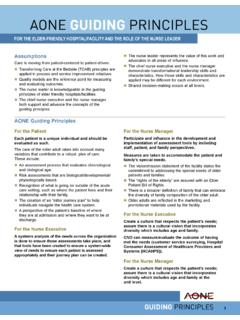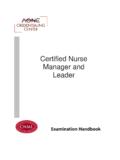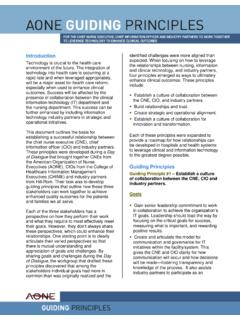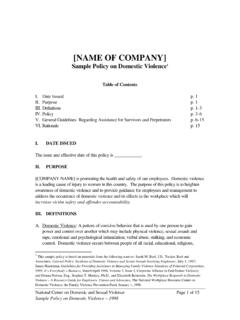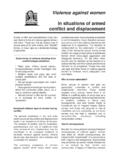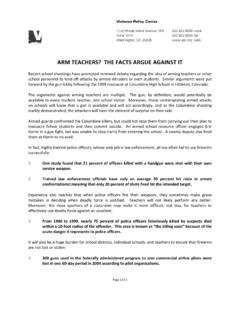Transcription of TOOLKIT FOR MITIGATING VIOLENCE IN THE …
1 TOOLKIT FOR MITIGATING VIOLENCE IN THE WORKPLACE. The American Organization of Nurse Executives (AONE) and the Emergency Nurses Association (ENA) in 2015 jointly released Guiding Principles on MITIGATING VIOLENCE in the Workplace. These principles provide a framework to systematically reduce lateral, and patient and family VIOLENCE in hospital settings. Research Conclusions: There are clear predictors and antecedents to VIOLENCE , both personal and environmental. There are varying levels of commitment to eliminating workplace VIOLENCE .
2 There is an underlying culture of acceptance in health care that may contribute to the incidence and prevalence of VIOLENCE , as well as difficulty in deriving solutions. The costs to nursing in terms of physical injury and financial loss are significant. The culture of acceptance may contribute to the difficulty in enacting and enforcing felony laws related to the assault of health care workers. Five focus areas critical to a successful workplace VIOLENCE prevention program: 1. Necessary Foundational Behaviors - What is the social environment of the institution or unit?
3 How do nurses relate to each other? What is the hierarchical structure of a given unit? The entire institution? Is there a sense of collaboration, or are disciplines working in silos? 2. Essential Elements of a Zero-tolerance policy How should environmental hazards be addressed? A code of conduct that defines and manages disruptive or inappropriate behavior by all staff, health care providers and administrators An identification system for potential VIOLENCE , response to threats or violent events, and constructive support procedures after the event Threats of VIOLENCE are acknowledged by hospital administration 3.
4 Ensuring Ownership and Accountability Does the institution embrace the Just Culture concept? Develop institutional and individual response protocols All staff understand the overall culture around VIOLENCE in the workplace and the specific behavior that comprise VIOLENCE in its myriad forms ( lateral (staff staff); organizational (administration staff);. and external (patients/visitors staff). 4. Proper Training and Education What are evidence-based training techniques? Evidence-based training in VIOLENCE recognition and mitigation De-escalation techniques; communication strategies and security strategies 5.)
5 Outcome Metrics How can a hospital measure success? Increased reporting of violent incidents Interventions in place to reduce escalation and assault Tracking of the nature and number of incidents institution-wide MITIGATING VIOLENCE in the Workplace TOOLKIT Page 1. This TOOLKIT provides nurse leaders with the resources needed to: 1. Understand workplace VIOLENCE 2. Develop a zero-tolerance policy 3. Assess the risk factors in your facility 4. Develop a workplace VIOLENCE prevention plan 5. Train and deploy staff 6. Evaluate the changes and identify next steps The TOOLKIT 's templates and tools provide an easy step-by-step procedure for customizing a VIOLENCE prevention plan that will meet the needs of your health care facility.
6 It also includes reporting templates to document your efforts. Step 1 - Understand workplace VIOLENCE How is workplace VIOLENCE defined? Occupational Health and Safety Administration (OSHA): Workplace VIOLENCE is any act or threat of physical VIOLENCE , harassment, intimidation, or other threatening disruptive behavior that occurs at the work site. It ranges from threats and verbal abuse to physical assaults and even homicide.. International Labour Organization: Any action, incident or behavior that departs from reasonable conduct in which a person is assaulted, threatened, harmed, injured in the course of, or as a direct result of, his or her work.
7 World Health Organization: The intentional use of physical force or power, threatened or actual, against oneself, another person, or against a group or community that either results in or has the likelihood of resulting in injury, death, psychological harm, mal-development or deprivation.. What types of workplace VIOLENCE exist in hospitals? VIOLENCE by Patients or families act committed by a person who is a patient in the hospital, family member of the patient or visitor at the hospital VIOLENCE by Co-workers (lateral) act committed by a colleague or another employee of the hospital ( current or former employee, supervisor or manager).
8 Step 2 - Develop a zero-tolerance policy Instituting a zero-tolerance workplace VIOLENCE policy sends a clear message to everyone working in the hospital that all threats or incidents of VIOLENCE will be taken seriously. The policy should clearly define what acts the organization considers to be violent behavior and what consequences will ensue if the policy is broken. What are some sample zero-tolerance policies? Nonprofit Risk Management Center OSHA. The American Society of Healthcare Risk Management TOOLKIT Suffolk Mental Health Partnership NHS Trust MITIGATING VIOLENCE in the Workplace TOOLKIT Page 2.
9 Step 3 - Assess the risk factors in your facility What are potential risk factors? High stress in the workplace Lack of appropriate training for supervisors Lack of appropriate management protocols for disciplinary actions Individual with a history of violent behavior How can workplace VIOLENCE hazards be reduced? Complete an assessment to examine your facility/department's vulnerability to incidents of VIOLENCE Analyze and track records of VIOLENCE at work Examine specific VIOLENCE incidents carefully and note the location of the incident Survey employees to gather ideas and input Minimize access by outsiders through identification badges, electronic keys and security guards Periodically inspect the worksite to identify risk factors that could contribute to injuries related to VIOLENCE o Where should security personnel, mirrors.
10 Panic buttons, video surveillance, etc be deployed? o Where are points of entry? o Where are patients/visitors likely to be frustrated by wait time, crowding or uncertain patient outcomes? How do I assess my facility? This step is focused on directing an initiative to obtain a comprehensive evaluation of the current status of workplace VIOLENCE in your facility/department. The tools below provide resources to conduct a multifaceted assessment that documents objective data (observations and facts) and subjective information acquired from your staff (bias and beliefs).


